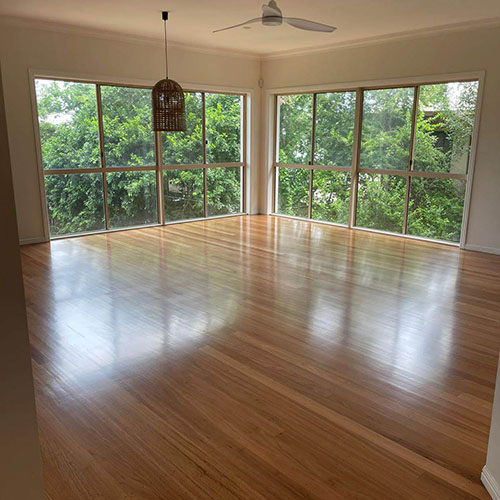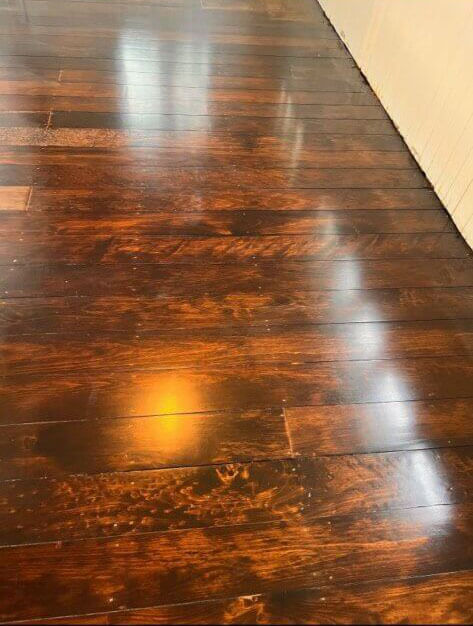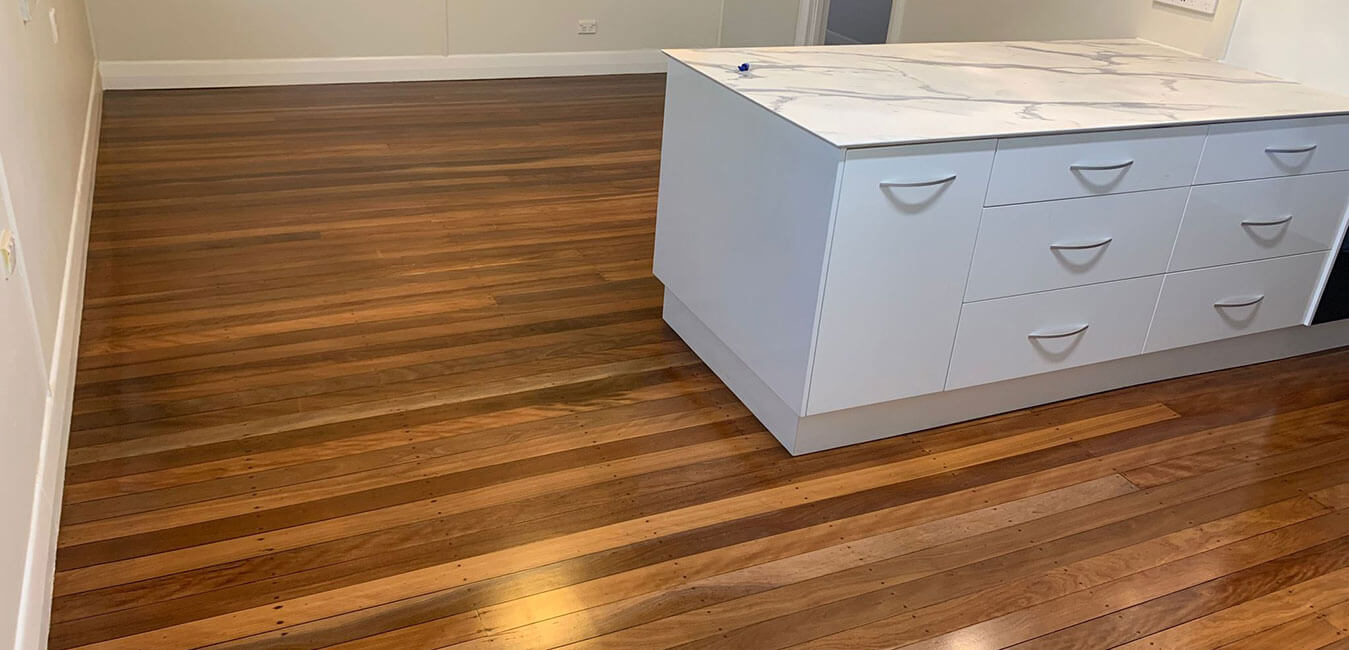Floor Sanding and Floor Polishing in Brisbane – No Obligation Free Quote Just a Call Away
We are a highly experienced, 5-star floor sanding company in Brisbane since 1993. With over 28 years in the trade, you can trust us to transform your timber floors impeccably. Whether old or new, stairs or decks, or you require floorboard replacements, we got you covered. Budget Floor Sanding is fully insured and licensed (#15254033) in Brisbane and all the surrounding areas.
- Free – Instant and No Obligation Quote
- In Your Budget with Quality Assurance
- Latest and state of the art equipment and tools
- Family Owned Business for thirty years
- Discount on advance booking for each month (10% off for November 2025)
Why Choose Budget Floor Sanding Within Your Budget without Compromising On Quality

Our professionalism and experience reflects not only in our Google place page profile reviews but you can also confirm our registration number with QBCC license and member of Australasian Timber Flooring Association (ATFA).
Call: 0418 882 678 and talk to Mr. Matthew Cutts.
How Much Time It Takes
Sanding, cleaning, polishing and coating takes time depending on area and condition of floor and it also depends on how much repair is required but here are estimated timeframes for normal or basic floor sanding projects in Brisbane.
- Small Bedroom (10–15 m²): 1 to 2 days for sanding and three coats.
- Medium Living Area (20–40 m²): 1 to 2 days sanding and three coats.
- Standard 3-Bedroom House: 3 to 4 days (sanding + 2–3 coats).
- Large Homes / Commercial Floors: 3 to 5 days depending on size.
- Drying & Curing Time: It takes 24 to 48 hours before walking on floors, and up to 1 week before replacing heavy furniture.
Our Recent Sanding Work
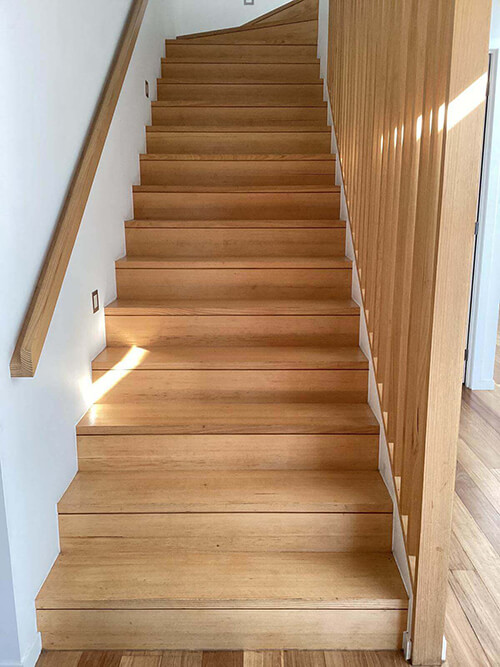
Before Sanding
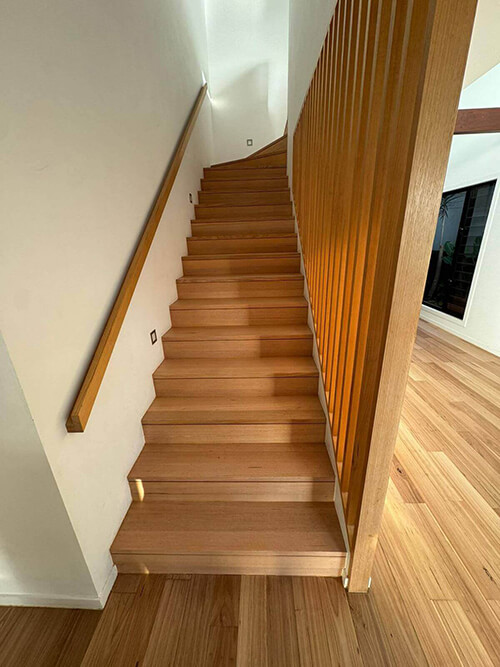
After Sanding
Quality and credibility
Quality work requires sufficient knowledge and dedication. The credibility of our work is evident in our completed projects and satisfied customers. We use high-quality equipment and products for our projects to maintain the quality standard. Rest assured, your wooden floor sanding job is under a trusted floor polishing company that is fully insured and has a current QBCC license.
Sustainable practices
We believe in green home building practices to minimize carbon footprint in the atmosphere. Ecological practices include:
- Dustless sanding technology prevents the spread of dust in the air.
- Non-toxic, eco-friendly natural oil finishes are plant-based polishes. They emit low VOCs and have less odor.
- Water-based polyurethane finishes are also preferred as they contain water as a solvent instead of mineral oils and turpentine.
- Our team responsibly manages waste products by collecting and disposing of dirt and debris produced during the process.
Local expertise
As a Brisbane-based company, we are familiar with the changing climate and weather patterns in our city and its suburbs (East, North, West, South, and Redcliffe). We guide our customers about the best time for timber floor sanding and the effects of changing weather on the timber which dissipates with time and doesn’t require sanding or other treatment procedures.
Budget-friendly services
We believe in transparent communication with you to bring your flooring ideas to life. We provide free quotes to homeowners on call for their timber floor-related queries. Our professional team visits and inspects the site to determine the extent of damage (for timber floor repair), consults with the homeowners to determine their budget and required work and provides a budget-friendly quote on-site.
Our Expertise
We specialize in repairing, sanding, and finishing all floors, including Maple, Oak, Jarrah, and Pine, as well as exotic species such as Mahogany and Teak. Our experienced team skillfully and carefully cares for your beautiful and unique hardwood floors to retain their characteristics and ensure a flawless finish that enhances their natural beauty.
Why Wooden Floor Sanding Is Important and When you Need One
Timber floors usually last decades with proper care but these factors play crucial role in scuffing, damaging boards, polish and top coats resulting in dull, uneven and hideous looking wooden floors.
Lobby And Kitchen
High traffic areas such as lobby and kitchen and main entrance get most of the brunt force of show screeching. These areas usually end up looking like a blob of yellowish scar on the floor and sometimes even dented inwards because of no timely care. Use rubberized mats in high traffic areas. When an area starts shining like a dull mirror, that’s when the area is too far gone. So, get it sanded and polished before that stage.
Heavy Furniture And Other Causes Of Damage
Heavy objects like furniture not only easily scratch the top coat but can also bend or break the boards. Use felt or carpet/rubber at the contact area. Never drop heavy objects on floor. If some boards get bent or damaged because of furniture, don’t use a hammer to fix it yourself because doing so may damage the adjacent boards and your floor will look like a mess.
Wood Swell And Deformity
Humidity can cause wooden boards to swell and ultimately permanently change the original shape and this is the main cause of uneven floors. In Brisbane, the humidity level is high and you can keep it lower with air conditioning and other de-humidifier appliances but a simple solution is not to put water on floor. Do not use pressure washer or steam cleaner.
Mold And Termite
Mold and termites may cause irreparable damage to your floor and we suggest immediate replacement of damaged floor boards with same type of wooden planks but with termite and fungus treatment and then go for sanding and polishing. Our team can examine your floor boards and devise a perfect strategy for your damaged floors.
What is Involved in Floor Sanding and Polishing?
The process includes sanding, polishing, and applying a finish. Floor sanding removes the top surface of the wood to eliminate imperfections and reveal a fresh layer of wood.
Floor polishing Brisbane adds a protective finish and enhances the appearance and durability.
Floor Preparation and Fixing process
Professional sanders in our team analyze the condition and select the correct equipment that is suitable for the specific wood type and intensity of the floorboard damage. process comprises the following steps:
- Preparation and cleaning of the premises with the help of a vacuum or a broom to start the sanding process.
- Concealing the non-movable items from the room with large protective sheets.
- Fixing the loose nails and screws on the floorboards.
What is Timber Floor Sanding process
The floor sanding process eliminates surface imperfections and gives your floors a new life.
- Sanding Starts: Sand the area along the wood grains to avoid damaging wood fibers using one of the sanders (orbital, drum, belt, or edge sander) with coarse grit sandpaper.
- Sand Paper Grit: The coarse grit (40- to 60-grit) removes old finishes, stains, and dents. Fine sanding follows coarse using fine grit (80-120).
- Smothing the Floor: It smooths the floor surface and prepares it to take the finish properly.
- Clearning and Vacuuming: Vacuuming the area again to remove dust from the process.
Timber Floor polishing process
A freshly sanded floor absorbs the polish better than a non-sanded floor. Sufficient penetration of the coating agent into the wood grains means enhanced durability and protection. The steps in the application of finish are:
How to Choose the Right Type of Polish
Waxes, water-based polyurethane, and oil-based polyurethane are popular finishes these days. You can also choose from glossy or matte finishes based on your interests. Water-based finishes are durable, non-yellowing, and emit low VOCs (volatile organic compounds). Oil-based finishes provide a warm tone to the timber by enhancing the grain pattern and are easy to maintain.
Multiple coats of polish with floor buffing in between ensure smooth finishing. Each coat is allowed to dry for sufficient time before the next coat is applied.
Oil-Based
Matte, Gloss, Silk
Moderate Durable
48 hrs–10 days cure
Water-Based
Satin, Gloss, Matte
Durable
6 hrs–5 days cure
Polyurethane
Satin, Semi-Gloss
Very Durable
7–10 days cure
The floor is allowed to cure fully after the application of the last coat of finish. Curing time varies for different finishes (oil-based floor polishes require more time to dry than water-based).
What is Timber Floor Staining Process
Timber floor staining in Brisbane is gaining huge popularity these days.
Staining is a process that is done between sanding and polishing to change the color or pigment of the wood.
After sanding and cleaning the area, we apply several coats of water based or oil based pigment coating depending on the wood type and desired color and let it dry for 72 hours before applying polish.
This is additional process and it adds to the cost but if you desire to change the look of your floor? it is a cost effective and less time consuming alternative to replacing the whole floor.
We Provide Sanding, Polishing, Repairs and New Floor Installation
DIY Pit Falls – A Free Quote Is All It Takes Why You Need a Professional Sander In Brisbane
Some home owners in Brisbane try to fix the scuff marks on high traffic areas or think that it is not a big deal, I can just sand the floor with my angle grinder or car polisher with any grit of sand paper and any off the shelf floor polish! I mean, How Hard Could It Be. Right? WRONG.
Over past 30 years we come across so many damaged projects that just needed a light touch and correct polishing technique to make it look like new but home owner already tried fixing it them self and permanently damaged the area because of lack of knowledge and technique to correctly sand a wooden floor and polish it.
Sanding a wooden floor is a blend of science and art. Anyone can operate a machine, but it takes years of hands-on experience and a keen eye for detail to master the techniques that ensure a flawless finish.
- The angle of the sanding machine approach
- Which grit sand paper to use on certain wood type
- What kind of polish will give you which kind of shine or stain or finish when it is cured properly
- Which nails to use and how not to damage planks when putting nails in
- How not to damage adjacent floor boards when changing a rotten or damaged area
There are several other factors that we learnt in past 30 years.
Conclusion
You are buying best skills acquired over 30 years in floor sanding trade – In your BUDGET
Get a Free Quote Call: 0418 882 678
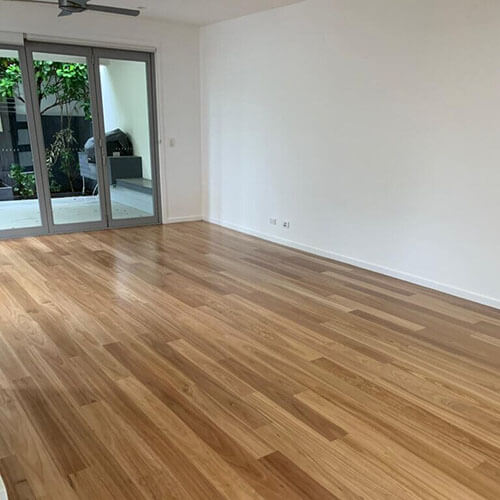
Lite polished room floor
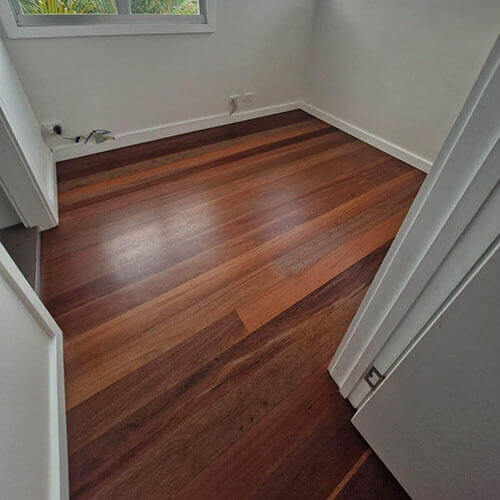
Stain wood matte finished small room wooden floor
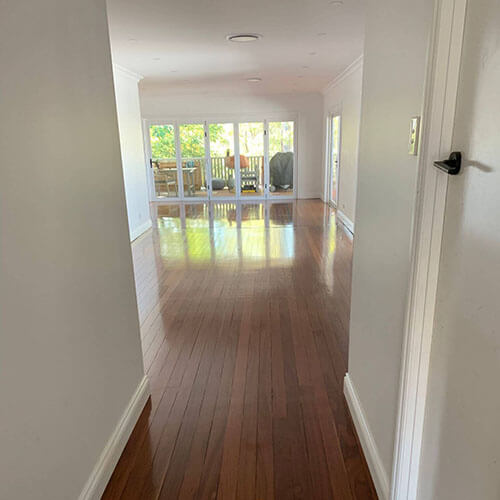
sanded and polished hallway with mirror finish
How much does a floor sanding cost in Brisbane
Deciding factors also include but not limited to the age and type of wood boards, how many boards needs to be replaced and how much consumable material (sand papers, machinery, wax and polish) needed for certain project. One should also keep the man hours required for the job in mind.
Here is a ballpark idea of what you should expect.
Timber Floor sanding in Brisbane costs may vary per square meter for basic sanding and polishing, staining top coat or lime wash costs extra. The rates have this much variation because it depends on desired finish, wood replacement boards cost and coating chemicals cost. We prefer using top the line nontoxic but a little bit expensive top coats.
How long it takes to finish a sanding and polishing project in Brisbane
As we mentioned about the cost that it depends on project, same could be said about the timeframe but with my 30 years of experience in this field I can say:
Do your timber floors need renovation?
Contact us for a FREE quote now!
Budget Floor Sanding is your local specialist in timber floor sanding. If your timber floors, stairs or deck need sanding and polishing, we can give you a free, no-obligation quote. Remotely or in person, it’s totally up to you! Fill out the below form fields and contact us now to get started.
Floor Sanding & Polishing FAQs
How much does timber floor sanding and polishing cost?
The sanding and polishing cost in Brisbane depends on the wood type, floor condition, area size, material cost.
Wood type: Engineered hardwood floors require careful sanding and extra time due to thin hardwood veneer as compared to solid hardwood floors.
Floor condition: The extent of damage determines the effort and quantity of products required to repair it.
Area size: The area size decides the cost per square meter. Larger areas require more labor, subsequently increasing the price.
Material Cost: The expense of purchasing new or reclaimed floorboards and the type of finish influence the total cost.
What is the duration to sand timber floors?
It depends on various factors, such as the floor size, current condition, and the desired finish.
A typical three-bedroom home usually takes anywhere from three days to seven days to complete, It heavily depends on the wood damage and the type of finish applied (cure time).
Do I need floorboard repairs before sanding?
Yes, any major damage like loose, warped, or severely worn boards and protruding nails must be repaired or replaced before sanding begins.
Unattended timber floors develop issues with time, such as warping, protruding nails, or general wear and tear. These issues significantly impact the durability and life of the floorboards. Uneven and damaged floorboards require replacement before sanding. Sanding the damaged floorboards causes uneven surfaces and affects the final polished result.
Is it economical to refinish timber floors or replace them?
Refinishing is always more economical than full replacement, provided that the existing floorboards are structurally sound and only got surface damage.
Floor repair or replacement is the homeowner’s decision after considering all the aspects. The major factor that can affect this decision is cost. Refinishing is economical if your floors have surface damage and need only sanding and polishing. Floor replacement is for highly damaged or bent floorboards. Timber floor refinishing involves sanding to remove imperfections and polishing to revitalize the floor. It saves labor and time and requires fewer materials to refinish the floors.
On the other hand, floor replacement involves removing all the planks and installing a new floor. Replacement is time-consuming and requires additional materials( polishing and coating agents after the planks are laid and fixed), leading to higher overall costs. Moreover, replacement involves more labor costs and can result in disruption and discomfort to your living space.
How long does floor finishing last?
Refinishing by a professional floor sander can last 7 to 15 years.
We use quality products that are tested and trusted by professionals, which reduces the extent of refinishing.
How often should I sand and polish my hardwood floors?
Hardwood floors typically require sanding and polishing every 7 to 10 years, though the actual longevity depends heavily on foot traffic, maintenance, and the finish type used.
Refinishing is essential when the there are signs of wear, including scratches, dullness, or discoloration. Regular maintenance through cleaning and promptly addressing spills can extend the time between refinishing.
How many times you can re-sand and polish a timber floor safely?
It mostly depends on the wood type. Woods like Oak, Maple, and Jarrah have high Janka scale readings, which means these floors have thick veneer and can be sanded five to seven times.
Engineered floors have thin veneer, limiting the number of sanding to two to three times. However, these numbers can vary based on the initial thickness of the wear layer, the professional’s expertise, and the care taken during the process.
It is crucial to consult a flooring company to determine and understand the characteristics of your timber floors.
What signs indicate my timber floor needs sanding vs. polishing?
Signs that indicate the need for floor treatment are surface wear and tear, discoloration, fading and scratches, it needs floor polishing. If you see deep scratches, significant discoloration, uneven areas, or have exposed raw timber then it needs floor sanding.
Floor polishing is the process of rejuvenating wood by eliminating small scratches and color fade. Floor sanding is necessary if issues arise with the floorboards. A patchy or rough surface with uneven areas indicates the need for floor sanding to smooth out imperfections. Stains from spills and discoloration from sunlight are the signs that the process is due.
How much does floor staining cost?
Timber floor staining costs may vary based on several key factors, including but not limited to the size of the area, the type of wood and stain used, and the overall complexity of the job.
Wooden floor staining Brisbane cost depends on the quality of stains and the number of coats affect the final quote. We recommend budget-friendly quotes based on your specific requirements and the condition of the existing floor.
What are the child and pet safety risks of floor polishing chemicals?
Polishing chemicals are hazardous for children and pets only when wet. Timber floor stains and polishes contain safe chemicals for children and pets after they are professionally applied and provided sufficient drying time.
The residents should avoid contact with the wet polish and keep children and pets away from newly polished floors. Oil-based and water-based floor finishes have low VOCs, making them environment-friendly. However, the old residents and patients should avoid entering the freshly polished floors, as they may experience difficulty breathing.
For additional safety, communicate with the professional floor sanders about the guidelines and precautions. Experts implement safety measures to maintain sufficient airflow during the stain application.

